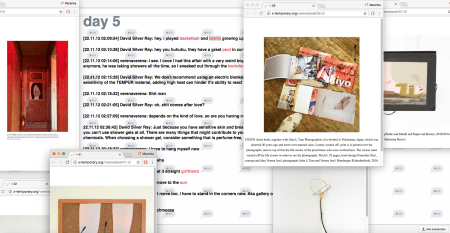Alienation or intimacy? Simultaneity, instant availability, seemingly endless space beneath flat surfaces. Why even differentiate between the virtual and the real? What’s contemporary now, anyway? Whether it’s criticism or praise, discussions concerning the digital realm and how it not only effects, but fundamentally shapes our ways of communicating, perceiving and creating inevitably lead to questions of temporality and spatiality. The Internet has redefined these two spheres, connecting places and people in a rhizomatic network, constantly adding layers and connections. Everywhere, all the time.
It’s this ephemeral, process-oriented quality of the digital that Berlin based curator Marenka Krasomil explores with her project x-temporary.org. Initiated in November 2016, the website functions as an online residency for artists who are invited to use the webspace for experimenting, creating and presenting site-specific work. “I want to conceive artistic practice from its processes of production and foreground the emergence of the work”, Marenka Krasomil says, comprehending her project also as an attempt to withdraw from the neoliberal structures and hierarchies of the art market.

Balz Isler, daily gestures (2016) via Marenka Krasomil/ x-temporary.org
Following this notion, the online residents are encouraged to reflect on how art can be produced and viewed online, using the website as a platform for time-based experimentation. After the month-long residency, the works that have come into being will be gone again. There’s no archive on x-temporary.org, only screenshots posted on Facebook or Instagram may or may not document past contributions. With its visually reduced aesthetic and its simple functionality, x-temporary.org is rather to be understood as a digital carte blanche, inviting the artists to, as the residency’s mission statement suggests, have fun.
For the first month, Berlin based Swiss artist Balz Isler published a series of drawings, daily gestures, which he created on his computer as a daily routine. Isler’s drawings of megaphones, teary eyes and speech bubbles call to mind quick, hand-drawn sketches. Black ink on white paper. What happens to the traditional, inherently physical medium of the drawing when transferred to the digital?
get real by Hamburg based artist Verena Issel presented a chat flirt between “verenaverena” and “David Silver Ray”, two semi-fictional characters who have met on a plane. Texting back and forth, their story was unfolding on the website with daily updates. Enticing, yet slightly awkward like a prime-time TV soap opera, get real addressed notions of romance and love, identity and self-staging in the age of online dating. “I’m fascinated by that shit. Social posing, honest acting. LOL. The internet is your stage.”[1]
The current contribution by Lina Hermsdorf, a graduate of the Städelschule in Frankfurt/Main now living in London, gives an insight into the artist’s methods of working, using the website as a space for research and inspiration.
The Internet is now an ubiquitous condition, rather than a useful tool. By giving space and a time-frame to artists to create and exhibit their work online, platforms such as x-temporary.org propose new forms of inhabiting the digital world – temporarily.

Verena Issel, get real (2016) via Marenka Krasomil/ x-temporary.org
Marie Sophie Beckmann
Marie Sophie Beckmann is a Berlin based writer and curator with a BA in Media and Cultural Studies and an MA in Curatorial Studies. In 2015, she co-founded the curatorial initiative EVBG which focuses on contemporary film and video art and feminist art practices.
Notes:
[1] From get ready by Verena Issel.
Featured image:
Lucia Graf, logo for x-temporary.org (2016)

